 |

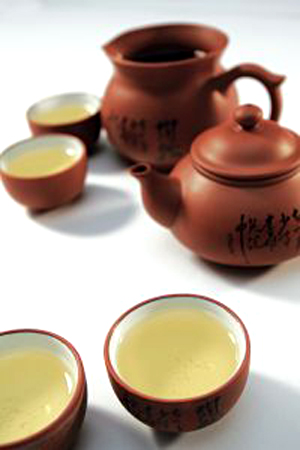 |
| Tzu Thé’s green tea is produced with higher levels of EGCG, the disease-fighting, health-abetting catechin. Catechins are flavonoids, powerful antioxidants. Learn more about them below.
Photo by Vince Chan. |
| WHAT IT IS: Pure, delicious, superpremium green tea produced with the highest standards. |
| WHY IT’S DIFFERENT: It’s grown and processed with rigorous supervision that ensures the highest levels of EGCG, the antioxidant in green tea that provides the health benefits. |
| WHY WE LOVE IT: In addition to the health benefits, this tea has exceptional flavor. Not only does it taste heavenly when brewed, but you can also use the leaves as a tasty herb on sweet or savory foods (just like thyme or rosemary). |
|
|
 |

Tea For Tzu:
Fine Tea From Tzu Thé
CAPSULE REPORT: With all the science behind green tea, we’ve found one green tea with better science. Tzu Thé (thé is the French spelling of tea, pronounced “tay,” Tzu means love) is a superpremium green with higher and more stable EGCG levels—which means more health benefits. It also has an exquisite, pure green tea flavor, never bitter, astringent or weedy. That’s a double win—but there’s more.
Because the protocols to grow and process this tea were developed by “the father of EGCG,” a professor of biochemistry at the University of Chicago who has spent 47 years researching the benefits of green tea, the company has made the tea very user-friendly. There are pre-measured grab-and-go capsules and infuser mechanisms so you can have fresh-brewed green tea wherever you are. There are tea-based nutrition bars; and the tea leaves themselves are so delicious. They can be eaten on yogurt, in salads et al. So whether you’re health-focused or are just looking for a delicious green, Tzu may well be your cup of tea. Read the full review below.
- There’s also an antioxidant glossary covering the myriad of terms surrounding green tea’s health benefits. (If your e-mail client does not support anchor links, scroll down.)
- For more of our favorite teas reviewed in THE NIBBLE online magazine, click here.
- For the table of contents of the June issue of THE NIBBLE, plus the back issues archive and our most popular articles, click here.
- All prior issues of the Top Pick Of The Week newsletter are archived here.
|
Green Tea Readings
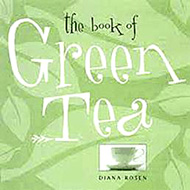 |
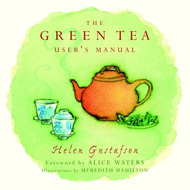 |
 |
| The Book of Green Tea, by Diana Rosen. Everything you ever wanted to know about green tea, including how to blend, brew and appreciate more than 120 varieties. This fun and informative book explains every aspect of green tea: where it grows, how its processed, its history and lore, how to drink and cook with it, and how to use it for beauty and health purposes. Click here for more information or to purchase. |
The Green Tea User’s Manual, by Helen Gustafson. Aficionados of green tea will welcome the knowledge and perspective of Gustafson, tea buyer for Alice Waters’ famous Chez Panisse restaurant. Short though this book may be, it thoroughly covers a subject not well understood in America: the uniqueness of green tea and its distinction from the familiar black tea. Click here for more information or to purchase. |
Tea Experience Digest. The premier magazine for tea enthusiasts. Articles about tea on every continent, innovative tea products and health benefits. A comprehensive directory of U.S. Tea Rooms, calendar of major tea-related events and a resources listing. The magazine demystifies tea and encourages readers to enjoy their tea experience. Annual subscription, 4 issues. Click here for more information or to purchase. |
Tea For Tzu: Superpremium, Super-Antioxidant Green Tea
Tzu Thé is a company with a mission to deliver EGCG-rich tea products to maximize health and wellness. This catechin*-rich green tea is the result of the lifelong work and passion of Shutsung T. Liao, Ph.D., an advisor to the company, who is a professor in the Ben May Institute for Cancer Research in the Department of Biochemistry and Molecular Biology at the University of Chicago. During his 47 years at the Institute, he has published more than 250 articles on cancer cell progression and treatment and has led the research in green tea polyphenols. Dr. Liao is often introduced as the “Father of EGCG,” the cancer-fighting catechin in green tea, for his discovery that EGCG is the key biochemical element that provides green tea’s many health benefits. His work established the foundations of the EGCG revolution: since the 1990s, research by Dr. Liao and others around the world has revealed that EGCG can suppress cancers and tumors, lower blood cholesterol and sugar, help digest excess fat and even protect against the common cold virus, cavities and cognitive degeneration.
*For a detailed explanation of catechins, EGCG, antioxidants et al, see the Antioxidant Glossary at the end of this article.
As a next step, to bring his scientific discoveries from the lab directly to the people, Dr. Liao wants to maximize the amount of EGCG in the tea by showing tea producers the best way to cultivate and manufacture tea and tea drinkers the best way to brew and drink it. EGCG can easily oxidize from green tea if people are drinking tea for health. Proper protocols prevent the oxidation and maximize its antioxidant powers.
Tzu Thé implements rigorous quality control measures throughout the entire production chain to ensure the levels of EGCG in the final product. From the production to the timing of harvest to the drying and the packaging process, each step is managed by careful scientific measurement in order to obtain the highest quality green tea possible. Carefully monitoring each production stock ensures that the content of catechins remains at the highest level. The result is an all-natural, whole-leaf green tea that is extremely rich in EGCG. (It is also 100 percent pesticide-free.)
|
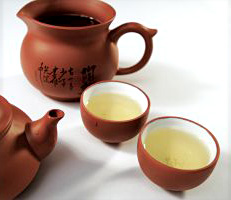 Just as with black teas, different green teas brew different colored liquors—some are pale green, some darker green, and some, like Tzu Thé, have a yellow cast. Photo by Vincent Chan.
Just as with black teas, different green teas brew different colored liquors—some are pale green, some darker green, and some, like Tzu Thé, have a yellow cast. Photo by Vincent Chan. |
Take a look at the different levels of EGCG in Tzu Thé versus regular Japanese green tea†: |
Content |
Japanese Green Tea |
Tzu Thé (Taiwanese) |
Water (%) |
2.83 |
2.58 |
PH value |
5.9 |
5.9 |
Caffeine (g) |
2.23 |
2.26 |
Gallic acid (GC) (g) |
0.04 |
0.01 |
Epigallocatechin (EGC) (g) |
1.87 |
3.363 |
Catechin (C) (g) |
0.12 |
0.076 |
Epicatechin (EC) (g) |
0.43 |
0.332 |
Epicatechin gallate (ECGC) (g) |
2.89 |
4.316 |
Epicatechin gallate(g) |
0.41 |
0.272 |
TOTAL CATECHIN (g) |
7.66 |
9.33 |
EGCG % OF TOTAL CATECHIN % |
37.7% |
46.25% |
†While our goal here is not to question the science presented, we want to point out that Chinese green tea and Japanese green tea in general have slightly different production techniques. In Japan, the plucked leaf is steamed; in China it is panned at a high temperature for a short period of time.
How Much Should You Drink?
Just how much green tea does a body need to fight off disease-engendering free radicals? Other sources cite eight cups of green tea daily to achieve the maximum EGCG benefit, and Dr. Liao’s prescription is similar:
- For daily use, 3 to 6 grams of dried green tea (1 to 2 tablespoons).
- For serious illness, 15 to 30 grams of dried green tea (5 to 10 tablespoons) may be needed.
- Since the body may gradually adapt to and destroy green tea EGCG, it may be a good idea to take green tea intermittently—on for 2 to 3 weeks and off for 1 to 2 weeks—especially for those who consume more than regular amount.
By the way, the amount of caffeine in one cup of green tea is about one quarter of that in a cup of coffee; i.e., the eight cups of green tea a day would add up to two cups of coffee.
O.K., you’re convinced that green tea’s antioxidants are good for you, and Tzu Thé in particular offers an extra abundance of them. So what does it taste like?
Products
Tzu Thé makes several products: loose tea, two portable tea infusers, the Tea Buddy drinking bottle and the T-2GO infusing kit, and T-Bar nutrition bars.
Loose Tea and Tea Pods
The tea itself should be anyone’s first introduction to what a great green tastes like. The aroma is 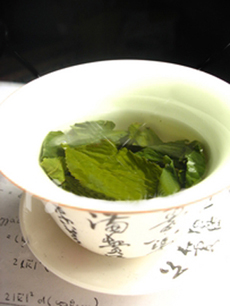 fresh and buoyant. The flavor is rich and full-bodied. Drunk plain (as green tea should be—never with sweetener or milk, which don’t complement the flavors of green or white tea), Tzu Thé is as filling and satisfying as bouillon. In essence, they are a comfort food. While you can taste the full essence of green tea, there are no strong notes—no herbal, grassy, weedy or other flavors that many people enjoy but which turn away others who want to drink more green tea for health (such people often turn to fruit-flavored greens to mask the natural flavors of green tea). There is no bitterness or astringency, even after the prescribed 20 minutes of steeping; and only the tiniest discernable astringency on the finish reminds you that tea contains tannin. While there are hundreds of varieties of green tea, each with its own distinctive flavor, Tzu Thé should prove itself a universal crowd-pleaser, perhaps the “chardonnay” of green teas. fresh and buoyant. The flavor is rich and full-bodied. Drunk plain (as green tea should be—never with sweetener or milk, which don’t complement the flavors of green or white tea), Tzu Thé is as filling and satisfying as bouillon. In essence, they are a comfort food. While you can taste the full essence of green tea, there are no strong notes—no herbal, grassy, weedy or other flavors that many people enjoy but which turn away others who want to drink more green tea for health (such people often turn to fruit-flavored greens to mask the natural flavors of green tea). There is no bitterness or astringency, even after the prescribed 20 minutes of steeping; and only the tiniest discernable astringency on the finish reminds you that tea contains tannin. While there are hundreds of varieties of green tea, each with its own distinctive flavor, Tzu Thé should prove itself a universal crowd-pleaser, perhaps the “chardonnay” of green teas.
The infused leaves are absolutely beautiful. If you haven’t bought fine, whole-leaf green tea, you’re in for a surprise. Unlike many infused tea leaves, which look ready to be tossed as soon as the tea is steeped, these whole green tea leaves look like fresh basil or some other leafy herb. Since green tea leaves aren’t roasted and oxidized, just briefly wilted and dried, by infusing them, they are brought back to life as moist as when they were on the tree. The leaves can be infused a second time. The full flavor is 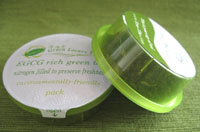 still there (as well as the EGCGs), and sometimes, even a third time. still there (as well as the EGCGs), and sometimes, even a third time.
The whole-leaf tea is available in both 150-gram metal canisters, and in individually-portioned plastic T-PODs (photo at right) that are nitrogen-filled to preserve freshness. Peel off the top and add the pre-measured amount of tea to one of Tzu Thé’s infusing devices, a regular tea strainer or other mechanism of choice (we favor the Adagio IngenuiTEA for home and office). See tips for brewing and storing tea in the green box below.
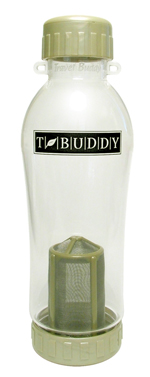 T-Buddy T-Buddy
Attractive, innovative and portable like a water bottle, the T-Buddy doubles as a tea bottle and a tea pot. It includes a built-in infuser for whole leaf tea: add the contents of a T-POD or any other leaf tea plus hot water. Thus, it’s simple to brew refills on the road; and of course you can fill it with water when you’re not using it for tea. T-Buddy comes with a high-quality carrying strap (not shown), and is available in 20- and 25-ounce sizes.
T-2GO
Another way to brew fresh green tea wherever you are is with a clever tumbler and infuser mechanism, T-2GO (photo below), a 3-in-1 device that has a removable plastic infusing “rim” that snaps onto any standard 12- or 16-ounce hot cup (it comes with a high-quality, reusable polypropylene hot cup). An infuser built into the plastic rim holds the loose tea, as a metal strainer would on a porcelain teacup. You pop in a T-POD and it infuses without spilling. Easy to carry, unbreakable and disposable, pre-packaged with T-PODs and a washable tumbler that can be used again and again, this is grab-and-go green tea. The leaves can be re-infused: depending on how strong you like your tea, each set could make two to three cups (they’re sold in packages of eight sets).
The review continues below with Tzu Thé’s “eating teas,” delicious tea nutrition bars, plus tips for adding more EGCG by eating whole or ground tea leaves in your everyday food.
Tips For Maximizing EGCGs
Brewing Tea
Vessel: Prevent the loss of EGCGs by using an airtight thermos or a covered cup while making tea. Drink the tea as soon as it is brewed (see Brewing Time, below); if it is too hot, add an ice cube or cold water.
Water: If your tap water isn’t delicious, use spring water or purified water. No matter how spectacular the tea, bad water will make a bad cup of tea.
Temperature: Bring the water just to boiling. Don’t over-boil or re-boil water, as much of the oxygen will boil out, resulting in a flat brew.
Brewing Time: Steep for 20 to 30 minutes for full release of EGCG. Tzu Thé tastes perfect after a very long infusion, which extracts the maximum amount of EGCG. It is important to note that other green teas can taste bitter when steeped longer than the normal 3 to 5 minutes.
- Use 1 heaping teaspoon per cup of water.
- Add hot water to the top of the thermos or cup to exclude air.
- Cover tightly and allow to stand for 20 to 30 minutes and drink immediately.
- If it’s too hot, don’t let it cool; add a small piece of ice. Never drink scalding hot tea and never leave tea cooling before drinking.
- You may add more boiling water and re-infuse the leaves for a second cup.
Storing Tea
Since the EGCG and another important catechin, ECG, can be oxidized by air and their anti-tumorigenic activity destroyed, some care should be exercised in the storage of tea leaves and in brewing the tea. The freshness of tea is important: catechin levels diminish as the tea ages (as does flavor):
- Buy green tea picked within a year. While tea is not currently date-stamped, buy from a specialist tea merchant with good turnover.
- Store tea green tea leaves in a moisture-proof container in the refrigerator.
|
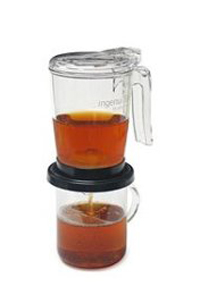
One of our favorite ways to brew tea is in the IngenuiTEA by Adagio—we own three. Simply fill with tea and hot
water. After the tea is steeped, put the pot on top of your cup or mug and the tea flows right in, straining out the leaves. It brews 16 ounces of tea at once. Click here to purchase or for more information. For our complete product review of the IngenuiTEA, click here. For our selection of glass mugs, below, click here.
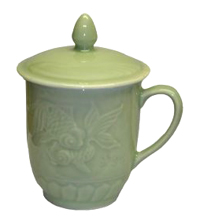
Following instructions to brew your tea in a covered vessel, this
celadon covered mug fits the bill. It can be microwaved to warm the tea. Set of 2. Click here to purchase or for more information. |
Glass Mugs For Tea
The British enjoyed tea from dainty white porcelain cups and saucers—because they drank it with milk. There was nothing much to look at except a creamy ecru or light tan color, so the focus of beauty was the cup. As with wine, tea comes in many colors, and part of the appreciation is enjoying the color of the liquor, as brewed tea is called. Here are some lovely glass mugs to afford you the pleasure.
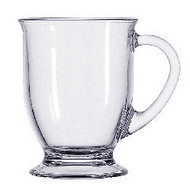 |
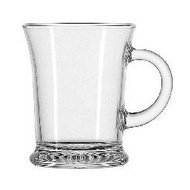 |
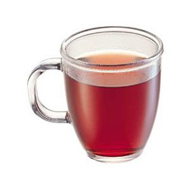 |
Anchor Hocking Cafe Mug. Anchor Hocking makes a quality product at a terrific price. Click here for more information or to purchase. |
Anchor Hocking Mocha Mug. A variation of style on the footed mug, Click here for more information or to purchase. |
Bodum Corona Glass Mug. We use this 11-ounce mug—graceful yet very sturdy—under our IngenuiTEA. Click here for more information or to purchase. |
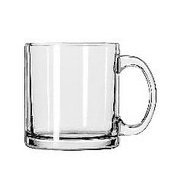 |
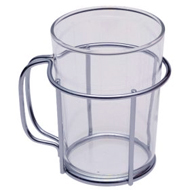 |
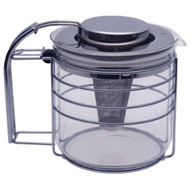 |
Libbey Glass Mug. Value-priced, this 13-ounce straight-edged mug is a bargain. Click here for more information or to purchase. |
Zeno Tea Glass. Stainless steel and glass, this sleek, exotic tea glass is a work of art and matches the teapot at the right. Click here for more information or to purchase. |
Zeno Stainless Steel and Glass Teapot with Infuser. Eight-cup teapot by WMF with a cone-shaped tea infuser that snaps out after brewing. Click here for more information or to purchase. |
Have Your Tea And Eat It Tzu
Tea Leaves
Dr. Liao’s research results suggest that either drinking brewed tea or eating the leaf achieves the same level of health benefit. For people who don’t like to drink green tea, or who want to maximize the amount of tea they consume, he recommends grinding green tea leaves to a powder in a coffee bean or spice grinder. Adding the powder to any beverage or food (smoothies, juice, dressings, seasonings, soups, milk and of course, green tea ice cream) will enhance the flavor. Blending with fruit and vegetable juices may make it easier for some people to consume larger amounts of green tea.
While we never say no to green tea ice cream, eating dried green tea in whole-leaf form is overall method we preferred. We wouldn’t think to do this with just any green tea, but Tzu Thé leaves are extremely tasty. We used them as an herb on yogurt, fruit salad, vegetable salads, potatoes (mashed, roasted and baked), fish, chops, pasta...for us, it became as tastily experimental as being handed rosemary for the first time. When we used it to garnish hors d’oeuvres, everyone asked what the herb was (no one guessed correctly). Tzu Thé was developed to be edible; being able to stump one’s sophisticated food friends is added value.
T–Bar Raw Green Tea Nutrition Bars
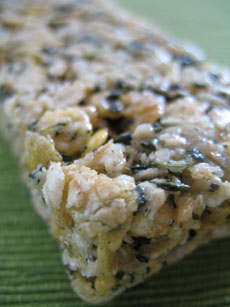
|
T–Bar is a whole-food nutrition bar that contains he same three grams of green tea as three cups of brewed tea. It’s an easy way to consume green tea for those who don’t like to drink it. There are three flavors, all cold-processed, made of 100 percent raw, non-GMO ingredients including sprouted whole grain brown rice, oats, buckwheat, rye, sesame tea and fructose. They taste like healthy granola bars and are a great source of fiber plus 14 minerals and 9 essential amino acids—in addition to all the EGCG.
Will you live longer by consuming appropriate amounts of green tea regularly? Quite possibly: laboratory research is strong and mounting, and for sure, it can only help. It will take years of clinical trials with control groups to quantify results between a tea-drinking group and a control group. In the interim, you can’t go wrong by drinking (and eating) delicious, EGCG-rich Tzu Thé. |
Photo by Melody Lan |
—Karen Hochman
FORWARD THIS NIBBLE to anyone who loves green tea, to people who are always looking for healthy foods, and to anyone seeking a fascinating new “herb.”
Tzu ThÉ
Green Tea, Nutrition Bars and Accoutrements
- Canister of Whole Leaf Green Tea
150 grams
$25.99
- T-PODs
Box Of 24 Pods
$25.99
- T-Buddy Bottle With Strap
20-Ounce, $22.99
25-Ounce, $24.99
- T2Go
Infusing Mechanism, T-POD and Tumbler
8 Sets (photo at lower right)
$14.00
- T-Bar
12 Bars, Assorted Flavors
$23.95
Purchase online at TzuThe.com
Read more about Tea
in THE NIBBLE Online Magazine:
Continue BELOW for:
|
 |
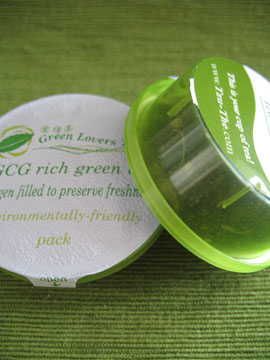
If you don’t want to measure loose tea, T-PODs, above, are pre-measured and sealed for freshness. Below, the white rim and clear infuser ball of T2GO snaps onto any hot cup, and a T-POD snaps in to infuse the tea with no spillage. Photos by Melody Lan.
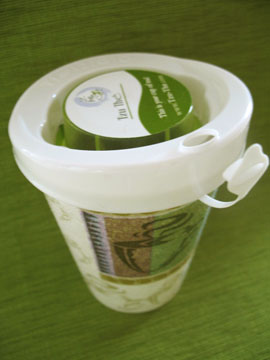 |
Favorite Tea Accessories
Antioxidant Glossary
One cup of green tea provides 10 to 40 mg of polyphenols and has antioxidant effects greater than a serving of broccoli, an antioxidant-rich food. The high antioxidant activity of green tea makes it beneficial for protecting the body from damage due to free radicals. Research shows that the EGCG in green tea may help the arterial wall by reducing lipids; green tea can protect against experimentally induced DNA damage, and much more. A 2006 study* showed that elderly Japanese people who drank more than 2 cups of green tea a day had a 50 percent lower chance of cognitive impairment than those who drank less green tea, or who consumed other tested beverages. The high amount of catechins in green tea are believed to be responsible.
*The American Journal of Clinical Nutrition, Vol. 83, pp. 355-361.
Antioxidants...free radicals...EGCG...catechins. What do these terms mean? We provide full definitions below. Essentially, there are many antioxidants with different degrees of strength. Green tea contains a particularly strong antioxidant, the catechin EGCG. Catechins are flavonoids, a subgroup of polyphenols, substances found in plants. Green tea has different catechins from black and oolong teas, due to processing (green and white teas are not oxidized). The hierarchy from bottom to top is:
| EGCG > |
Catechin> |
Flavonoid> |
Polyphenol> |
Plant |
| Antioxidant |
Antioxidant |
Antioxidant |
Antioxidant |
Tea tree, yielding
unoxidized
green and white teas |
- Antioxidant: An enzyme or other organic molecule that reduces the rate of particular oxidation reactions and can counteract the damaging effects of oxygen in tissues. Although the term technically applies to molecules reacting with oxygen, it is often applied to molecules that protect from any free radical (a molecule with unpaired electron). While new foods seem to appear every day touting higher levels of antioxidants (the latest is the açai berry from the rainforests of Brazil). On the list of general-distribution supermarket foods, those with the highest level of antioxidants are, in order of strength: undutched cocoa powder, bittersweet chocolate (particularly that which is 85% or more in cocoa solids), white tea, green rooibos, green tea, red rooibos, oolong tea, black tea, blueberry (especially wild blueberry, a.k.a. bilberry) which contains more antioxidants than any other fruit or vegetable—when compared on the basis of equal calories. Other fruits and berries are high in antioxidants, especially: blackberry and raspberry, cranberry, cherry (especially sour cherry), dried plum (prune), dark grapes (including raisins, purple grape juice and red wine), crowberry (a North American berry that looks similar to a blueberry), kiwi, pomegranate, papaya (a source of vitamin E, lycopene and beta-carotene, three very powerful antioxidants), citrus fruit such as orange and grapefruit (the highest concentration of antioxidants are in the pulp, where its pectin is found); and leafy, dark green cruciferous vegetables (broccoli, brussels sprouts, cabbage, cauliflower, daikon radish, kale, kohlrabi, mustard/chard greens, parsnip, rutabaga, turnip and watercress). For a more extensive list, click here.
- Catechin: Biochemically, catechins are monomers (molecules that can be chemically bound as a unit of a polymer) of flavanol, a subclass of flavonoids, which are themselves a subclass of polyphenols. Catechins make up some 25 percent of the dry weight of fresh tea leaf. The concentration of catechins is higher in green and white tea†; in black and oolong teas the oxidation process allows polyphenol oxidase to oxidize the polyphenols, which inactivates the catechins. Tea contains four main catechin substances: EC, ECg, EGC and EGCg, all of which are inclusively called “catechin.” Epigallocatechin gallate (EGCG) is the one most abundant in tea. EGCG as an antioxidant is about 25 to 100 times more potent than antioxidant vitamins C and E. (Tea flavor, color and astringency is in part due to the condensation of the catechins to form the bright orange-red pigment theaflavin.) Researchers believe that catechin is effective because it easily sticks to proteins, blocking bacteria from adhering to cell walls and disrupting their ability to destroy them. Viruses have hooks on their surfaces and can attach to cell walls. The catechin in green tea prevents viruses from adhering and causing harm. Catechin reacts with toxins created by harmful bacteria and metals such as lead, mercury, chrome and cadmium.
†White tea is substantially more expensive than green tea, and has a few more catechins per serving.
- EGCG: Epigallocatechin gallate, a specific antioxidant compound found in green tea and elsewhere, is a key biological and biochemical driver for many health benefits, for reasons noted in the preceding paragraph. It can reduce cancers and tumors, prevent cancer cells from growing, lower cholesterol, help digest excess fat and even protect against the common cold virus. Worldwide studies are ongoing and reported regularly that discover new health benefits.
- Flavonoids: A large group of water-soluble plant pigments commonly referred to as bioflavonoids in the media. All flavonoids are biological in origin, so the two terms are interchangeable. Flavonoids are most commonly known as powerful antioxidants, protecting against oxidative and free radical damage. They have been referred to as “nature’s biological response modifiers” because of strong experimental evidence of their ability to modify the body’s reaction to allergens, viruses and carcinogens: they show anti-allergy, anti-inflammatory, anti-microbial and anti-cancer activity. As a result, consumers and food manufacturers have become interested in flavonoids for their medicinal properties, especially their potential role in the prevention of cancers and cardiovascular disease. The beneficial effects of fruit, vegetables, tea and red wine have been attributed to flavonoid compounds. Cocoa is loaded with the flavonoid epicatechin; cocoa has been found to have nearly twice the antioxidant content of red wine and up to three times that of green tea (dark chocolate should be consumed with a cocoa content of seventy percent or greater). Other good sources of flavonoids include all citrus fruits, berries, onions, parsley and legumes, plus green tea and red wine.
- Free Radicals: Highly unstable and reactive molecules that attack, infiltrate and injure vital cell structures. They are constantly formed as a natural by-product of body chemistry. Free radicals are highly toxic and can damage important cellular molecules such as DNA, lipids or other parts of the cell, impairing the brain and other tissue. They are believed to accelerate the progression of age-related and other diseases.
- Green Tea: All tea comes from the leaves of the Camellia sinensis plant (referred to as the tea tree, tea plant or tea bush); the difference in the many varieties of tea lies in the processing and the terroir (the difference in Indian versus Chinese versus Japanese growing environments, and different regional environments within countries, e.g.). Unlike black and oolong teas, green tea is made from leaves that are not fermented before they are dried. Thus, green tea’s antioxidants are five times higher than black tea. Green tea is also high in vitamin C. Green tea is produced by panning freshly picked tea leaves at a high temperature for a short period of time to stop oxidation before it starts, which also preserves most of the polyphenols. (Note: See also White Tea. White tea is also not fermented and is even higher in antioxidants.)
- Polyphenols: Polyphenols are a group of chemical substances found in plants. Research indicates that the flavonoids, a class of polyphenols, has antioxidant characteristics with potential health benefits that may reduce the risk of cardiovascular disease and cancer. Polyphenols are potent antioxidant compounds that have demonstrated greater antioxidant protection than vitamins C and E. Green tea may also increase the activity of antioxidant enzymes. Green tea polyphenols may inhibit cancer by blocking the formation of cancer-causing compounds and suppressing the activation of carcinogens. The major polyphenols in green tea are flavonoids: catechin, epicatechin, epicatechin gallate, epigallocatechin gallate (EGCG) and proanthocyanidins. Though both green tea and black tea are derived from the same plant (Camellia sinensis), they possess different antioxidants. In producing black tea the leaves are allowed to oxidize, during which enzymes present in the tea convert many polyphenols to larger molecules with different biological effects. However, green tea is produced by lightly steaming the fresh-cut leaf, which inactivates these enzymes, and oxidation does not occur. Sources of polyphenols include peanuts, green tea, white tea, red wine, olive oil, dark chocolate, pomegranates, and other fruits and vegetables. Chocolate or cocoa that has been processed with alkali (dutched cocoa) will not contain any polyphenols or antioxidants.
- White Tea: White tea is made mostly from the buds of the tea plant. White tea is not oxidized: the tea remains in its natural state, subject only to withering and firing. The buds are withered or wilted in the shade while subjected to cool circulating air, to allow the moisture to evaporate; then are gently dried in natural sunlight. The most delicate tasting of teas, it also has the highest concentration of antioxidants. The color of dried tea is actually light green; the curled-up white tea buds have a silvery/white appearance due to fine, silvery white hairs or down that cover the buds and young leaves. The taste is similar to the green tea but sweeter and milder.
Information courtesy of Wikipedia and Tzu Thé. |
FOR ADDITIONAL INFORMATION, special offers,
contests, opinion surveys, THE NIBBLE
prior issues archive, product gift-finder, links to our favorite
food websites, and the ability to nominate YOUR favorite nibbles,
visit the home page of TheNibble.com.
Do you have friends who would enjoy THE NIBBLE?
Click here to send them an invitation to sign up for their own copy. |
ABOUT THE NIBBLE. THE NIBBLE, Great Food Finds, is an online magazine about specialty foods and the gourmet life. It is the only consumer publication and website that focuses on reviewing the best specialty foods and beverages, in every category. The magazine also covers tabletop items, gourmet housewares, and other areas of interest to people who love fine food. This e-mail from the editors features the top food pick of the week. You can read the complete magazine and past issues at TheNibble.com.
To unsubscribe, send an e-mail to Editors(at)TheNibble.com.
To contact us with comments or suggestions, click here. If you received
this from a friend but would like to subscribe directly, go to www.TheNibble.com.
© Copyright 2004-2026 Lifestyle Direct, Inc. All rights
reserved. All information contained herein is subject to change at any time
without notice. All details must be directly confirmed with manufacturers, service
establishments and other third parties. The material in this newsletter may not
be reproduced, distributed, transmitted, cached, or otherwise used, except with
the prior written permission of Lifestyle Direct, Inc.
|
 |
|
 |








 fresh and buoyant. The flavor is rich and full-bodied. Drunk plain (as green tea should be—never with sweetener or milk, which don’t complement the flavors of green or white tea), Tzu Thé is as filling and satisfying as bouillon. In essence, they are a comfort food. While you can taste the full essence of green tea, there are no strong notes—no herbal, grassy, weedy or other flavors that many people enjoy but which turn away others who want to drink more green tea for health (such people often turn to fruit-flavored greens to mask the natural flavors of green tea). There is no bitterness or astringency, even after the prescribed 20 minutes of steeping; and only the tiniest discernable astringency on the finish reminds you that tea contains tannin. While there are hundreds of varieties of green tea, each with its own distinctive flavor, Tzu Thé should prove itself a universal crowd-pleaser, perhaps the “chardonnay” of green teas.
fresh and buoyant. The flavor is rich and full-bodied. Drunk plain (as green tea should be—never with sweetener or milk, which don’t complement the flavors of green or white tea), Tzu Thé is as filling and satisfying as bouillon. In essence, they are a comfort food. While you can taste the full essence of green tea, there are no strong notes—no herbal, grassy, weedy or other flavors that many people enjoy but which turn away others who want to drink more green tea for health (such people often turn to fruit-flavored greens to mask the natural flavors of green tea). There is no bitterness or astringency, even after the prescribed 20 minutes of steeping; and only the tiniest discernable astringency on the finish reminds you that tea contains tannin. While there are hundreds of varieties of green tea, each with its own distinctive flavor, Tzu Thé should prove itself a universal crowd-pleaser, perhaps the “chardonnay” of green teas. still there (as well as the EGCGs), and sometimes, even a third time.
still there (as well as the EGCGs), and sometimes, even a third time.  T-Buddy
T-Buddy









